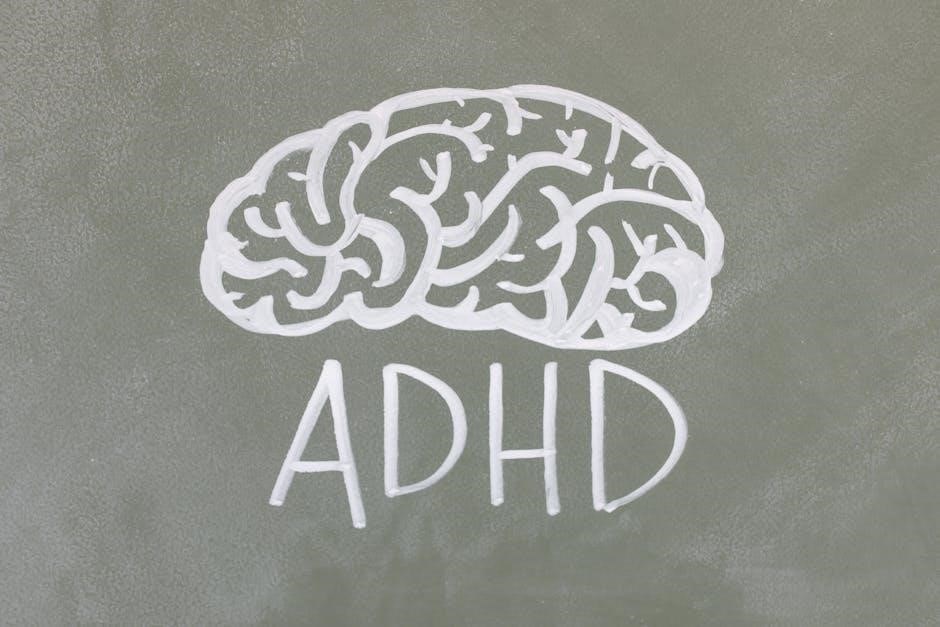The Conners Scale is a widely used tool for assessing ADHD symptoms, developed by C. Keith Conners. It evaluates behavioral issues in children and adults, providing insights into attention deficits and hyperactivity. Available as a PDF, it includes forms like the CPRS, CTRS, and ASQ, aiding in accurate diagnosis and intervention planning.
Overview of the Conners Scale for ADHD
The Conners Scale is a comprehensive assessment tool designed to evaluate symptoms of Attention-Deficit/Hyperactivity Disorder (ADHD) in individuals. It includes forms like the Conners Parent Rating Scale-Revised (CPRS-R) and the Conners Teacher Rating Scale-Revised (CTRS-R), which gather information on behavioral patterns. The scale assesses key areas such as inattention, hyperactivity, and impulsivity, providing valuable insights for diagnosis and intervention planning. Regular updates by Multi-Health Systems, Inc., ensure its relevance and accuracy in clinical and educational settings. Available as a PDF, it remains a widely used resource for ADHD assessment.
Importance of the Conners Scale in ADHD Diagnosis
The Conners Scale plays a crucial role in ADHD diagnosis by providing a standardized method to assess symptoms like inattention and hyperactivity. It offers a comprehensive evaluation of behavioral patterns, aiding clinicians in making accurate diagnoses. Early identification through this tool enables timely interventions, improving outcomes for individuals. Its widespread use in clinical and educational settings underscores its reliability and effectiveness in guiding treatment plans. While not a standalone diagnostic tool, it remains a vital component of a comprehensive ADHD assessment process, ensuring a well-rounded evaluation.

History and Development of the Conners Scale
The Conners Scale was introduced by Multi-Health Systems, Inc. (MHS) in 1970. It has undergone regular updates, with the Conners 4 being the latest version.
Origins of the Conners Scale
The Conners Scale was developed by Dr. C; Keith Conners in the 1970s as a comprehensive tool to assess ADHD symptoms. Initially designed to evaluate behavioral issues in children, it has since expanded to include adult assessments. The scale’s creation was driven by the need for a standardized method to identify attention deficits and hyperactivity. Over time, it has evolved to align with DSM criteria, ensuring its relevance in clinical and educational settings. Its origins mark a significant advancement in ADHD diagnosis and management.
Evolution of the Conners Scale Over Time
The Conners Scale has undergone significant updates since its introduction in the 1970s. Initially developed to assess childhood behavioral issues, it evolved to align with DSM criteria for ADHD. The Conners 4, its latest version, incorporates feedback from clinicians and educators, enhancing accuracy. Regular revisions ensure it remains a reliable tool for diagnosing ADHD in both children and adults. Its evolution reflects advancements in understanding ADHD, with updated forms like the Abbreviated Symptom Questionnaire (ASQ) for quicker assessments. This adaptability has solidified its role in clinical and educational settings.

Structure of the Conners Scale
The Conners Scale consists of multiple forms, including the Parent Rating Scale (CPRS), Teacher Rating Scale (CTRS), and Abbreviated Symptom Questionnaire (ASQ). Each form assesses ADHD symptoms.
Conners Parent Rating Scale (CPRS)
The Conners Parent Rating Scale (CPRS) is a comprehensive tool designed for parents and caregivers to assess ADHD symptoms in children. It evaluates various behavioral aspects, including inattention, hyperactivity, and emotional difficulties. The CPRS provides detailed insights into a child’s behavior patterns, helping professionals diagnose ADHD accurately. Available in a revised format, it includes specific items aligned with DSM-5 criteria, ensuring up-to-date assessment standards. This scale is a valuable resource for both clinical and educational settings, aiding in intervention planning and monitoring progress.
Conners Teacher Rating Scale (CTRS)
The Conners Teacher Rating Scale (CTRS) is a valuable assessment tool designed for teachers to evaluate ADHD symptoms in students. It focuses on behaviors observed in the classroom, such as inattention, hyperactivity, and impulsivity. The CTRS provides educators with insights into how a child’s behavior impacts their academic performance and social interactions. Available as part of the Conners 4 suite, it includes revised forms that align with DSM-5 criteria, ensuring accurate and reliable results. This scale is essential for developing targeted intervention strategies and monitoring progress over time.
Conners Abbreviated Symptom Questionnaire (ASQ)
The Conners Abbreviated Symptom Questionnaire (ASQ) is a concise assessment tool designed to evaluate ADHD symptoms in children and adolescents. It is often used by parents and teachers to provide quick insights into behavioral concerns. The ASQ focuses on key symptoms such as inattention, hyperactivity, and impulsivity, making it an efficient screening instrument. Its brevity and targeted approach allow for rapid identification of potential ADHD indicators, supporting early intervention and further evaluation. However, it should be used as part of a comprehensive diagnostic process.
Administration and Scoring
The Conners Scale is administered to parents, teachers, and self-reporting individuals. Scoring involves evaluating symptoms based on a Likert scale, with results interpreted by professionals to guide ADHD assessments.
How the Conners Scale is Administered
The Conners Scale is administered to parents, teachers, and self-reporting individuals to assess ADHD symptoms. Parents and teachers complete the CPRS and CTRS forms, rating behaviors observed at home and school. Self-reporting versions are available for older children and adults. The scale uses a Likert scale format, ranging from 0 (not true at all) to 3 (very much true). Responses are collected on provided forms, ensuring systematic evaluation of symptoms. This method ensures comprehensive data collection for accurate ADHD assessment.
Scoring and Interpretation of Results
The Conners Scale is scored by summing responses across items, with higher scores indicating more severe symptoms. T-scores and percentile ranks are used to interpret results, comparing them to normative samples. Scores are categorized into ranges, with elevated scores suggesting significant ADHD symptoms. Clinicians interpret these scores to assess symptom severity and guide diagnosis. The scale also provides subscale scores for specific traits like inattention and hyperactivity, aiding in targeted interventions. Accurate interpretation requires trained professionals to ensure reliable and valid results for ADHD assessment.

Effectiveness and Reliability
The Conners Scale is an evidence-based, validated tool for assessing ADHD symptoms, offering reliable results when administered correctly. Regular updates ensure its accuracy and relevance in clinical practice.
Research indicates the Conners Scale is a reliable tool for assessing ADHD symptoms, with studies confirming its accuracy in measuring attention deficits and hyperactivity. Its validity is supported by consistent results across diverse populations, making it a trusted instrument in clinical settings. Regular updates ensure alignment with DSM-V criteria, enhancing its relevance and effectiveness in diagnosing ADHD accurately. The Conners Scale is often compared to other ADHD assessment tools like the Vanderbilt Assessment Scale and the ADHD Rating Scale (ADHD-RS). While the Vanderbilt is known for its comprehensive approach, the ADHD-RS focuses specifically on DSM-5 criteria. The Conners Scale stands out for its detailed evaluation of both inattention and hyperactivity, making it a preferred choice for clinicians. However, it requires more time to administer and scoring by a professional, which can be a drawback compared to shorter scales. Despite this, its thoroughness ensures a more accurate diagnosis. The Conners Scale is widely applied in clinical and educational settings to assess ADHD symptoms, aiding in diagnosis, treatment monitoring, and intervention planning for children and adults. The Conners Scale is a vital tool in clinical settings for diagnosing and managing ADHD. Clinicians use it to assess symptoms like inattention and hyperactivity, guiding accurate diagnoses. The scale’s structured format helps track treatment progress, ensuring effective intervention plans. By providing standardized data, it supports informed decision-making and personalized care for patients. Its reliability and validity make it a preferred choice among healthcare professionals for comprehensive ADHD assessment. The Conners Scale is widely utilized in schools to identify ADHD symptoms in students. Teachers use the Conners Teacher Rating Scale (CTRS) to assess inattention, hyperactivity, and impulsivity. This tool helps educators develop tailored learning strategies and support plans. By providing insights into a student’s behavior, it facilitates collaboration between teachers and parents, ensuring a consistent approach to managing ADHD. The scale’s effectiveness in educational settings enhances academic outcomes and social integration for students with ADHD. The Conners Scale, while useful, has limitations. Critics argue it may not fully capture ADHD complexity and relies heavily on subjective ratings, potentially leading to biased results. The Conners Scale, while valuable, has several drawbacks. It relies heavily on subjective ratings, which may introduce bias. Critics note it may not fully capture the complexity of ADHD, as it focuses on specific symptoms rather than broader behavioral patterns. Additionally, its effectiveness can vary across cultural and developmental contexts, potentially limiting accuracy. Some studies suggest it may overdiagnose or underdiagnose ADHD in certain cases. Proper training and interpretation are essential to mitigate these issues, ensuring reliable results. It should not be used as the sole diagnostic tool for ADHD assessment. Research studies have highlighted several criticisms of the Conners Scale. Some argue that it may overdiagnose ADHD due to its focus on symptom presence rather than functional impairment. Cultural biases in the scale’s development have also been noted, potentially leading to inaccurate assessments in diverse populations. Additionally, critics point out that the scale’s reliance on subjective ratings can introduce variability. Studies suggest it may not fully capture the complexity of ADHD, particularly in cases with comorbid conditions. These limitations underscore the need for comprehensive diagnostic approaches beyond the Conners Scale alone. The Conners Scale for ADHD is a versatile tool used in clinical and educational settings. It offers detailed scoring sheets and guidelines for accurate assessment, ensuring reliable results. The Conners Scale for ADHD is available in PDF format through authorized distributors like Multi-Health Systems (MHS). Professionals can purchase access online, ensuring they receive the most updated versions, including the Conners 4. The PDF includes rating scales for parents, teachers, and self-reports, along with scoring sheets and interpretation guides. It’s essential to obtain the scale from reputable sources to maintain its validity and reliability in ADHD assessments. Proper licensing ensures ethical and accurate use in clinical and educational settings. Proper use of the Conners Scale requires training and licensure, ensuring accurate administration and interpretation. Administer the scale in clinical or educational settings, adhering to MHS guidelines. Interpret results by comparing T-scores to norms, with elevated scores indicating potential ADHD symptoms. Combine scale results with comprehensive diagnostic assessments for accurate conclusions. Avoid relying solely on the scale for diagnosis, as it should complement other evaluations, such as clinical interviews and behavioral observations, to ensure a comprehensive understanding of the individual’s condition. Proper interpretation is crucial for effective diagnosis and intervention planning.Research on the Accuracy of the Conners Scale
Comparison with Other ADHD Assessment Tools

Applications of the Conners Scale
Use in Clinical Settings
Use in Educational Settings

Limitations and Criticisms
Potential Drawbacks of the Conners Scale
Criticisms from Research Studies
Practical Applications and Resources
Accessing the Conners Scale for ADHD PDF
Guidelines for Proper Use and Interpretation































































